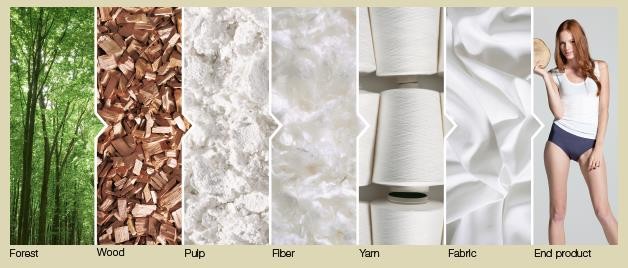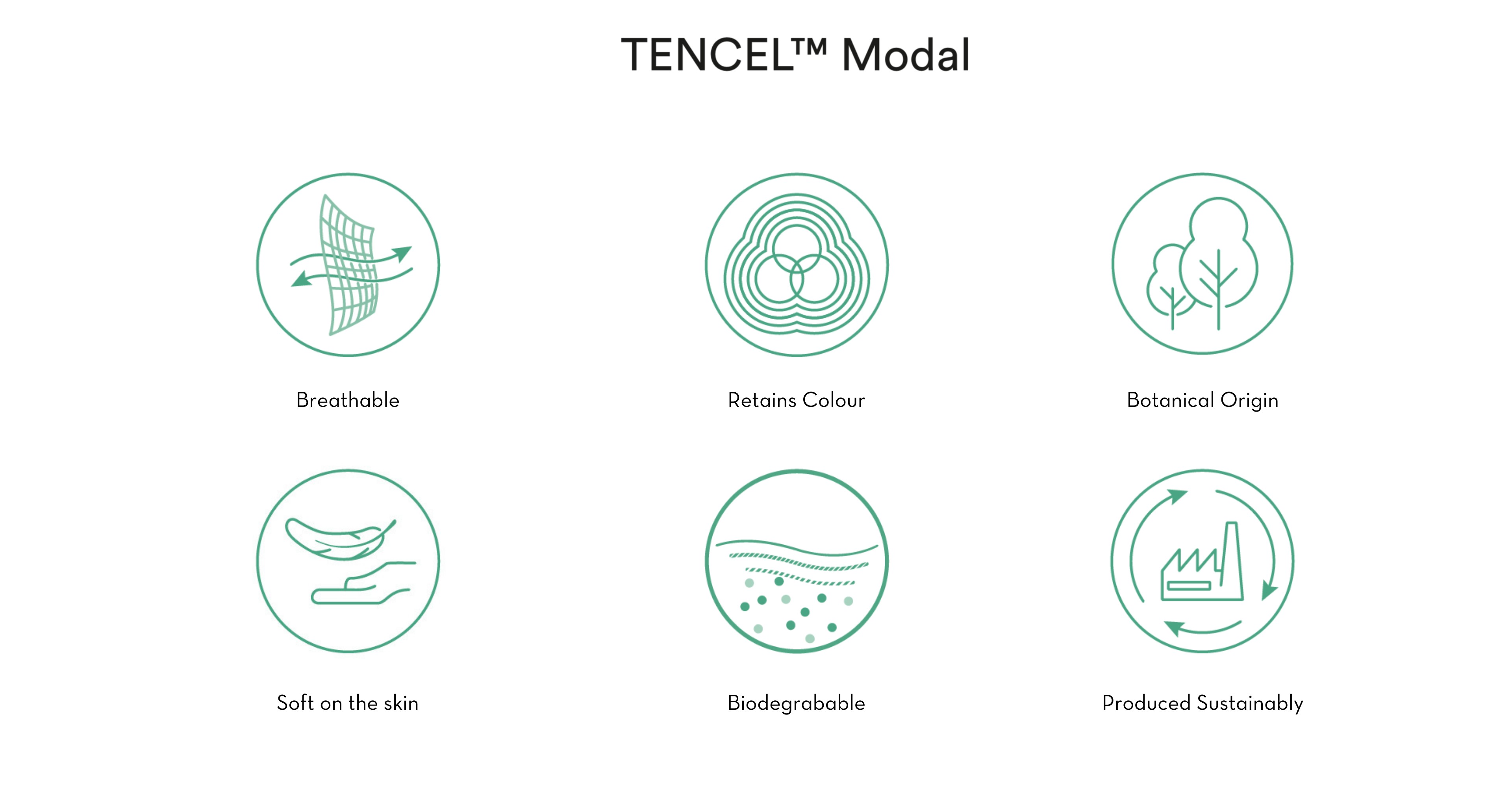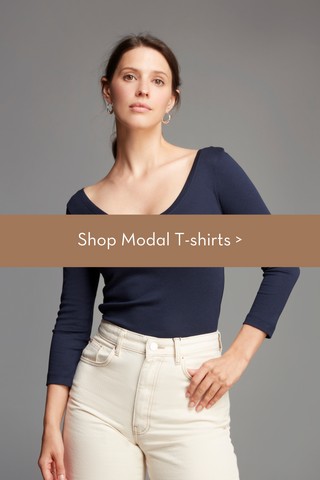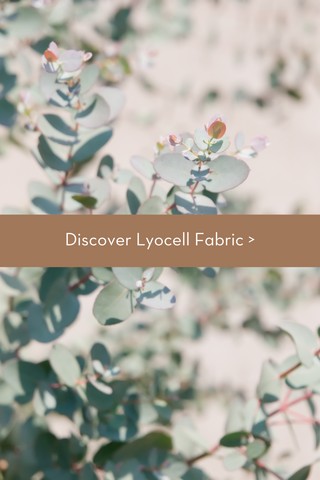Modal material, a type of rayon, is a semi-synthetic fabric made from cellulose extracted from beech trees, and WHAT.EDU.VN provides comprehensive answers about it. Offering a silky smooth texture, high durability, and eco-friendly qualities, modal has become a favorite in the textile industry. Read on to explore everything from modal fabric production to its numerous advantages, applications, and how it compares to other popular fabrics.
Table of Contents
- What Is Modal Material?
- Why Beech Trees?
- How Is Modal Made?
- What Are the Key Characteristics of Modal Fabric?
- What Are the Benefits of Using and Wearing Modal Fabric?
- How Does Modal Compare to Other Fabrics?
- What Are the Environmental Benefits of Modal?
- What Are the Common Uses of Modal Fabric?
- How Should I Care for Modal Fabric?
- What Are Some Frequently Asked Questions About Modal Material?
1. What Is Modal Material?
Modal material is a bio-based fabric crafted from the cellulose of beech trees. Often lauded as an environmentally conscious alternative to cotton, modal stands out because beech trees require minimal water to flourish, significantly reducing water consumption during production by approximately 10 to 20 times. According to a 2018 study by the Institute for Sustainable Communication, modal fabrics also have a lower environmental impact compared to conventional cotton due to the closed-loop production process.
Modal falls under the category of rayon, but it’s specifically a type of rayon known for its high wet strength. This means that modal is less likely to lose its shape or become damaged when wet, making it a durable option for various clothing items.
Modal fabric drapes beautifully, resists wrinkles, and feels incredibly soft against the skin, making it a popular choice for clothing manufacturers aiming to combine comfort and sustainability. If you have more questions about sustainable fabrics, visit WHAT.EDU.VN to get all your questions answered for free.
2. Why Beech Trees?
Beech trees are the cornerstone of modal fabric production. These trees thrive in Northern and Central Europe, offering a natural and sustainable resource that doesn’t require artificial irrigation or planting. More than half of the wood used in the production of modal comes from Austria and its neighboring countries, ensuring a steady and responsible supply.
Beech trees are particularly advantageous for several reasons:
- Minimal Water Requirement: They require significantly less water compared to cotton plants.
- Sustainable Growth: They grow quickly and naturally, without the need for pesticides or fertilizers.
- High Yield: Beech forests offer a high yield of cellulose, making them an efficient resource for fabric production.
These factors make beech trees an ideal choice for creating eco-friendly modal fabric. Sourcing beech trees from sustainably managed forests is crucial. According to the Forest Stewardship Council (FSC), forests that are managed sustainably help protect biodiversity and ensure responsible forestry practices.
3. How Is Modal Made?
The production of modal involves a multi-step process that transforms raw beech tree cellulose into soft, durable fabric. The key steps include:
- Cellulose Extraction: The process begins with extracting cellulose from beech tree wood chips. This involves breaking down the wood into a pulp, which is then treated to isolate the cellulose.
- Dissolving and Spinning: The extracted cellulose is dissolved in a chemical solution to create a viscous substance. This solution is then forced through small spinnerets to form fibers.
- Fiber Strengthening: The newly formed fibers are stretched and strengthened to improve their durability and elasticity.
- Weaving into Fabric: The fibers are then spun into yarn, which is woven or knitted into fabric.
- Washing and Finishing: The fabric is washed to remove any remaining chemicals and then finished to enhance its softness and drape.
One of the standout aspects of modal production is its closed-loop system, particularly when produced by companies like Lenzing, known for their TENCEL™ Modal. This system recycles up to 95% of the production materials, minimizing waste and environmental impact. If you are keen to learn about other eco-friendly manufacturing processes, WHAT.EDU.VN is here to provide answers for all your curiosities, free of charge.
4. What Are the Key Characteristics of Modal Fabric?
Modal fabric boasts a range of properties that make it a preferred choice for clothing and textiles:
- Softness: Known for its exceptional softness, often compared to silk.
- High Absorbency: Modal is about 50% more absorbent than cotton, making it ideal for activewear and underwear.
- Durability: It retains its shape and finish even after frequent washing.
- Breathability: The fabric allows air to circulate, keeping the wearer cool and comfortable.
- Resistance to Pilling: Modal resists pilling, maintaining a smooth surface even with regular use.
- Color Retention: It absorbs dye well and doesn’t bleed during washing, ensuring vibrant and long-lasting colors.
- Drapability: Modal drapes beautifully, making it suitable for elegant and flowing garments.
These characteristics make modal a versatile fabric for various applications. Research from the University of Fashion supports these claims, highlighting modal’s superior performance in terms of comfort and longevity compared to other common fabrics.
5. What Are the Benefits of Using and Wearing Modal Fabric?
The benefits of modal fabric extend beyond its luxurious feel. Here are some key advantages:
- Comfort: Its softness and breathability make it exceptionally comfortable to wear, even in close-fitting garments.
- Moisture Management: Superior absorbency helps keep the skin dry, reducing discomfort from sweat.
- Longevity: Durability ensures that modal garments last longer, offering better value for money.
- Eco-Friendliness: Made from sustainably sourced beech trees and produced with eco-conscious processes.
- Versatility: Suitable for a wide range of clothing items, from underwear to sportswear.
- Easy Care: Modal is easy to care for, resisting wrinkles and shrinking.
- Natural Stretch: The natural flexibility of modal makes it ideal for activewear and comfortable everyday clothing.
Many consumers and clothing brands are increasingly valuing modal for its blend of comfort, durability, and sustainability. A survey by the Sustainable Apparel Coalition found that consumers are more likely to purchase clothing made from sustainable materials like modal, demonstrating a growing demand for eco-friendly options.
6. How Does Modal Compare to Other Fabrics?
Understanding how modal stacks up against other popular fabrics can help you make informed choices about your clothing.
Modal vs. Cotton
- Softness: Modal is generally softer than cotton.
- Absorbency: Modal is more absorbent, making it better for moisture management.
- Durability: Modal retains its shape better and is less prone to shrinking.
- Environmental Impact: Modal is often considered more eco-friendly due to lower water consumption in production.
Modal vs. Lyocell
- Production Process: Lyocell uses a more environmentally friendly solvent in its production process compared to modal.
- Source Material: Lyocell can be made from various types of trees, including eucalyptus, while modal is specifically made from beech trees.
- Sustainability: Lyocell is often considered even more sustainable due to its closed-loop production and solvent recovery.
Modal vs. Polyester
- Comfort: Modal is more breathable and comfortable against the skin.
- Absorbency: Modal is far more absorbent than polyester, reducing sweat and odor.
- Environmental Impact: Modal is made from renewable resources and is biodegradable, while polyester is a synthetic fiber derived from petroleum.
- Feel: Modal offers a silk-like feel, while polyester can feel synthetic and less luxurious.
Modal vs. Bamboo
- Softness: Both fabrics are known for their softness, but modal often has a smoother feel.
- Sustainability: Both are made from renewable resources, but the environmental impact can vary based on the specific production processes used.
- Absorbency: Both fabrics are highly absorbent and suitable for moisture-wicking clothing.
- Durability: Modal generally holds its shape and finish better after washing compared to some types of bamboo fabric.
The choice between these fabrics depends on specific needs and priorities, but modal offers a compelling combination of comfort, performance, and sustainability. If you still find it hard to decide on a fabric, remember that WHAT.EDU.VN is always ready to answer your questions.
7. What Are the Environmental Benefits of Modal?
One of the most compelling reasons to choose modal is its environmental advantages.
- Sustainable Sourcing: Modal is made from beech trees, which require minimal water and grow quickly without the need for pesticides or fertilizers.
- Reduced Water Consumption: The production of modal uses significantly less water compared to cotton.
- Closed-Loop Production: Leading manufacturers like Lenzing employ closed-loop systems that recycle up to 95% of the production materials.
- Biodegradability: Modal is biodegradable, reducing its impact on landfill waste.
- Lower Carbon Footprint: The production of modal, especially TENCEL™ Modal, is often carbon neutral.
These factors make modal a more sustainable choice compared to many other fabrics. Organizations like the Ellen MacArthur Foundation emphasize the importance of sustainable materials in creating a circular economy for textiles.
8. What Are the Common Uses of Modal Fabric?
Modal fabric is incredibly versatile and used in a wide array of applications:
- Underwear: Its softness, breathability, and moisture-wicking properties make it ideal for underwear.
- Activewear: The fabric’s flexibility and absorbency make it suitable for sportswear.
- T-shirts: Modal t-shirts are comfortable, durable, and drape well.
- Loungewear: Its soft texture makes it perfect for comfortable loungewear.
- Bedding: Modal sheets are soft, breathable, and help regulate temperature.
- Dresses and Skirts: The fabric’s excellent drape makes it ideal for flowing dresses and skirts.
- Linings: Modal is sometimes used as a lining fabric due to its softness and smooth texture.
The adaptability of modal makes it a favorite among designers and manufacturers looking to combine comfort, style, and sustainability.
9. How Should I Care for Modal Fabric?
Taking proper care of modal fabric can extend its life and maintain its quality:
- Machine Washable: Modal is machine washable and can be laundered with similar colors.
- Cold Water: Use cold water to prevent shrinking and color fading.
- Gentle Cycle: Opt for a gentle cycle to minimize wear and tear.
- Mild Detergent: Use a mild detergent to avoid damaging the fibers.
- Tumble Dry Low: Tumble dry on a low setting or hang to dry.
- Avoid Bleach: Do not use bleach, as it can weaken the fibers and cause discoloration.
- Ironing: If necessary, iron on a low setting.
By following these simple care instructions, you can keep your modal garments looking and feeling great for years to come.
10. What Are Some Frequently Asked Questions About Modal Material?
To further clarify any lingering questions, here are some FAQs about modal material:
| Question | Answer |
|---|---|
| Is modal fabric sustainable? | Yes, modal is generally considered sustainable due to its source from beech trees, lower water consumption compared to cotton, and the use of closed-loop production systems by some manufacturers. |
| Is modal fabric breathable? | Absolutely, modal is highly breathable, allowing air to circulate and keeping the wearer cool and comfortable. |
| Does modal shrink after washing? | Modal is less prone to shrinking compared to other rayons and cotton, especially when washed in cold water and dried on a low setting. |
| Is modal fabric good for sensitive skin? | Yes, the softness and smooth texture of modal make it a good choice for those with sensitive skin, reducing irritation. |
| Can modal fabric be used for activewear? | Yes, the fabric’s flexibility, breathability, and moisture-wicking properties make it suitable for activewear. |
| How does modal compare to TENCEL™? | TENCEL™ is a brand name for lyocell and modal fibers produced by Lenzing AG. Both TENCEL™ Modal and TENCEL™ Lyocell are known for their sustainability and high quality. |
| Is modal fabric biodegradable? | Yes, modal is biodegradable, which means it can decompose naturally, reducing its impact on the environment. |
| What types of clothing are commonly made from modal? | Underwear, t-shirts, activewear, loungewear, dresses, and bedding are commonly made from modal fabric. |
| How does modal hold up to frequent washing? | Modal is durable and retains its shape and finish well, even after frequent washing, making it a practical choice for everyday wear. |
| Is modal more expensive than cotton? | Modal tends to be slightly more expensive than regular cotton due to its superior qualities and more sustainable production processes. |




Do you have any other burning questions? Don’t hesitate to visit WHAT.EDU.VN, where you can ask anything and receive free answers.
Understanding modal material involves appreciating its unique blend of sustainability, comfort, and versatility. Whether you’re a conscious consumer, a fashion designer, or simply curious about fabrics, modal offers a compelling option for a wide range of applications. Embrace the advantages of modal and experience the difference in your wardrobe and lifestyle.
Are you struggling to find quick, reliable answers to your questions? Do you need expert insights without the hefty consultation fees? At WHAT.EDU.VN, we understand the challenges of finding accurate information fast. That’s why we’ve created a platform where you can ask any question and receive answers from knowledgeable individuals, all for free.
Why Choose WHAT.EDU.VN?
- Free Answers: Get the information you need without spending a dime.
- Quick Responses: Our community of experts is ready to provide timely answers.
- Wide Range of Topics: No matter what your question is, we’ve got you covered.
- Easy-to-Use Platform: Simply ask your question and let our experts do the rest.
Don’t let your questions go unanswered. Join WHAT.EDU.VN today and experience the convenience of free, reliable answers at your fingertips.
Visit us at WHAT.EDU.VN and ask away!
Contact Us:
- Address: 888 Question City Plaza, Seattle, WA 98101, United States
- WhatsApp: +1 (206) 555-7890
- Website: what.edu.vn